Ruina Manual#
Versatile stereo multi-distortion with wavefolding, octavizing, phase shifting, multiband saturation, filtering, and DOOM, plus a powerful modulation system.

Overview#
Ruina is a creative stereo distortion plugin built on digital distortion algorithms: no emulations here. Intuitive and fully automatable controls make it easy to get a gentle, nuanced color, to obliterate a signal, or to dial in anything in between. Don’t feel like tweaking the parameters? Ruina comes with tons of presets to fit any need.
Ruina has a multiband saturator, a wavefolder, a chaotic suboctave generator, octavizer, and phase shifter. It also features a notch or bandpass filter with adjustable tracking, and a control to set the order of the distortions in the signal flow to further customize your sound. Last but not least, Overdrive adds up to 128x gain for maximal destruction.
Ruina comes with extensive modulation options and is fully MIDI mappable. Run any sound through Ruina for warm, lush distortion, or crank the sliders to unleash complete destruction. We love Ruina with vocals, percussion, synths, strings, and of course guitars. You name it, it sounds great with Ruina.
With seven distortion types, it’s easy to turn your sounds into something new and unique with Ruina.
Installation#
Windows#
Log into portal.noiseengineering.us Navigate to the “Plugins” tab, and click the link that says “Download for Windows” Double-click the downloaded file to run it. NE Products will use your web browser to authenticate your plugins. Log into your Portal account on the webpage that opens if prompted, then return to NE Products. Click on “Install/Update Plugins”. Close NE Products, run your DAW, and your plugins will appear!
Mac#
Log into portal.noiseengineering.us Navigate to the “Plugins” tab, and click the link that says “Download for Mac” When the download completes, open the installer file and follow the instructions. Open NE Products. On Mac, it can be found with Finder in Applications or with Spotlight. NE Products will use your web browser to authenticate your plugins when you run it. Log into your Portal account on the webpage that opens if prompted, then return to NE Products. Click on “Install/Update Plugins”. Once plugins are installed, the message at the top of the screen will display “Your plugins are up to date.” Close NE Products, run your DAW, and your plugins will appear!
- Ableton Live troubleshooting
- If you've installed your plugins but they aren't showing up in Ableton Live, please open Live, navigate to the
Pluginstab inPreferences, and make sure thatUse VST3 Plug-In System Foldersis turned toOn.
Uninstallation#
Run NE Products again, and click “Uninstall Plugins.” If you’d like to also remove their preset files, click “Uninstall Plugins and Presets.” Doing this removes all presets in the factory directories, including user-created presets, so please copy any files you’d like to save to a different location before performing this action.
Shortcuts#
- Cmd/Ctrl+Click or Cmd/Ctrl+Mouse wheel
- For finer control, hold Cmd (Mac) or Ctrl (PC) while moving a parameter.
- Double click
- Resets any parameter to its default state.
- Scroll
- Hover over any parameter and scroll to adjust. Scroll+Cmd (Mac) or Scroll+Ctrl (PC) give finer control.
All of these work to edit step levels in LFO Step shape as well.
Tone page#

- Volume In
- Input audio level.
- Volume Out
- Master output level.
- Blend
- Dry/wet balance control. When fully left, the unmodified input signal is passed through. Fully right, only the processed signal is heard. Points in the middle give you a mix of both.
- Overdrive
- Amount of gain (up to 128x) added to a signal before it hits the rest of the distortion types.
- Phase
- Phase shifts the left and right signals to create stereo-width and/or phasing effects.
- Fold
- Wavefolder, based on the Noise Engineering Infinifolder that appears onmany of our Eurorack modules like the Basimilus Iteritas Alter.
- Center
- Width and position of the multiband-saturator center band, and of the filter when set to “Mobile”.
- Saturate
- Multiband saturator, inspired by our analog distortion module Seca Ruina. Emphasizes the four different bands, isolating the lowest when fully left and the highest when turned fully right. Blends through low, low-mid, high-mid, and high bands at other settings.
- Octavize
- A full-wave rectification distortion, inspired by our analog distortion module Pura Ruina.
- Doom
- Doom is a suboctave chorus. Imagine it like a suboctave generator, but evil: as you turn it up, the louder the suboctave is, and the more out-of-tune it becomes.
- Buzz
- Adds overtone buzz to a signal, creating width and high-frequency content.
- Filter Level
- Sets the intensity of the filter.
- Filter Track
- Sets the filter to a fixed frequency or to follow the frequency of the Center parameter.
- Filter Type
- Changes the filter from a notch in “Cancilla” mode and a resonant and aggressive bandpass filter in “Boscio” mode.
- Flow
- Changes the signal chain of the distortion.
-
Under: Fold -> DOOM -> Octavize-> Saturate
-
Cross: Fold -> Saturate -> Octavize-> DOOM
-
Over: Fold -> DOOM -> Octavize-> Saturate -> Fold (again)
Presets#
Presets are stored in the computer’s file system, and the controls below allow for modification and navigation through the files and folders of presets. You can create a new preset “Category” by creating a subfolder in the preset directory, and saving new presets within it.
- load
- Load a preset.
- save
- Save a new preset.
- < > (category)
- Loads the next/previous folder of presets in the preset directory.
- < > (preset)
- Loads the next/previous preset.
- nudge
- Applies a small amount of randomization to all tonal parameters and modes. Randomization can be bypassed per control in individual parameter modulation menus. Useful for creating slight variations of sounds.
- rand
- Completely randomizes all tonal parameters and modes. Randomization can be bypassed per control in individual parameter modulation menus. Use this to create inspiring new sounds and ideas.
- reset
- Resets all parameters to their default settings.
Modulation#
All Noise Engineering plugins feature a comprehensive routing system making use of a variety of modulation types and sources. When modulation is enabled on a parameter, a box showing the range of enabled modulation will appear, and a small indicator will move within the range box showing the exact position of the modulation.

Types of modulation#
- Parameters can be modulated from a variety of sources:
- LFOs
- Four onboard LFOs that offer a variety of modes, from simple waveforms to step sequencers. More detail on LFO modes can be found in the section below titled “Modulation page.”
- Macros
- Four macro sliders can be assigned to any number of parameters. The macros can in turn be mapped to MIDI controllers, automated, or modulated with other LFOs.
- Env
- Envelope follower. Turns the dynamics of the incoming signal into a modulation source.
- MIDI CC
- Parameters can be assigned to MIDI CCs. (Note: MIDI mapping of effects is not supported in all DAWs.)
Modulation Assignment#
When a parameter is right-clicked (Control+click on Mac), a context menu appears with modulation routing options:
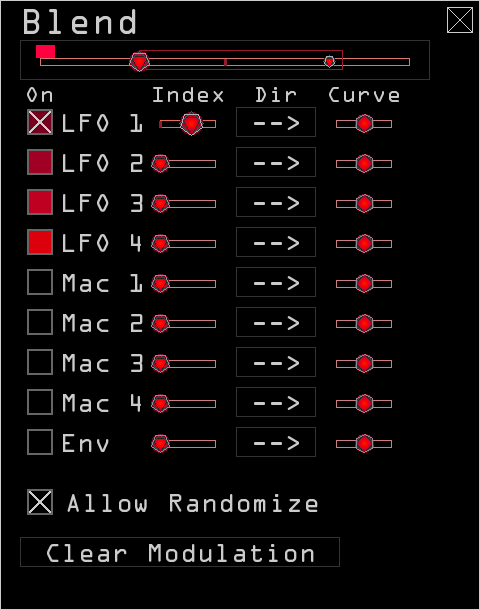
- Parameter slider
- A copy of the parameter being modulated, for easy adjustment.
- On
- Each modulation source has a checkbox; when checked, modulation from that source is enabled.
- Index
- Sets the amount of modulation from a particular source. Fully left, modulation is bypassed.
- Dir
- Direction. Sets the polarity and inversion of incoming modulation.
- --> (unipolar): modulates from the point selected on the parameter up to the level indicated by the Index setting
- <-> (bipolar): modulates around the center point set by the parameter
- <-- (inverted unipolar): opposite modulation from unipolar
- >-< (inverted bipolar): opposite modulation from bipolar
- Curve
- Each modulation source has a Curve slider that changes how modulation affects the parameter. In the center, modulation is linear, and the parameter movement matches incoming modulation exactly. To the right modulation is more logarithmic, and to the left more exponential.
- Allow Randomize
- When checked, this parameter can be randomized when “rand” (Tone page) is clicked.
- Learn CC (only visible when MIDI Learn is checked on the Config > Interface page)
- Click this to enable MIDI CC learn on a parameter. Move a parameter on your MIDI controller and the plugin will exit learn mode and the parameter will now respond to that CC. If clicked by mistake, click
Waiting on CCto exit learn mode. ClickForget CCto remove an assignment. - Clear modulation
- Resets modulation checkboxes, amounts, direction, and curve. Does not affect CC assignments.
Modulation Page#
Click the sections in the left column to navigate to that page and edit modulator settings and routings.
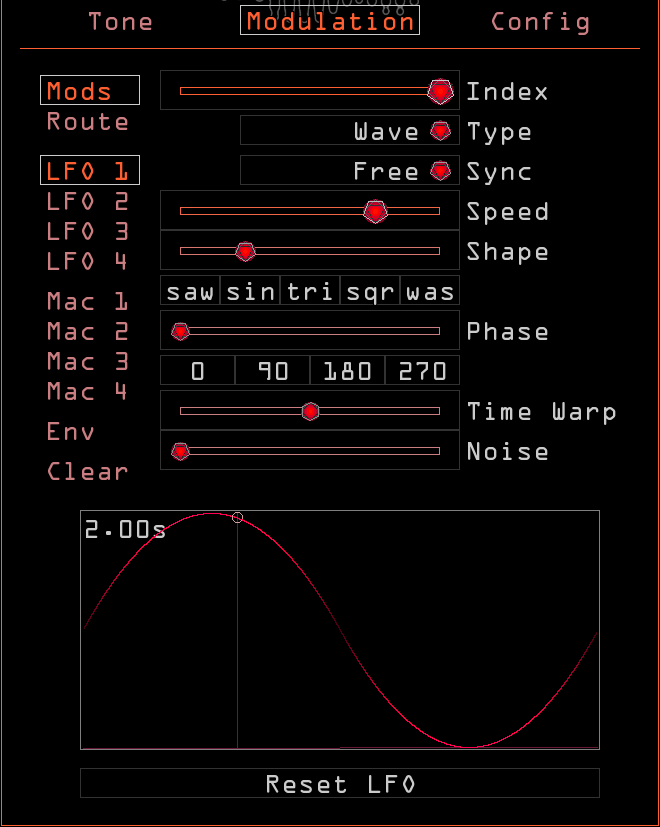
LFO 1-4#
- Index
- Sets the modulation range of the LFO.
- Type
- Sets the type of LFO. Options include Wave, Step, and ADR, described in detail in the sections below.
- Sync
- Sets the source of timing for the modulator. * Free: A single completely freerunning LFO; never resets. * Transport: Speed is set in seconds, but the LFO follows the transport of the DAW. * Tempo: A single LFO that is synced to the DAW’s tempo and transport.
- Speed/Beats
- Sets the rate of the LFO. In unsynced modes, this is a slider that sets the rate in seconds. In synced modes (Tempo and Poly Tempo), this is a fraction that sets the rate in beats (for example,
4/1would be equal to 1 bar in 4/4 meter). If a synced mode is selected, the rate can be doubled or halved with the*2and/2buttons respectively. - Reset LFO
- Resets the LFO back to its default state, respecting Type.
Type: Wave#

- Shape
- Morphs between different waveforms.
- saw/sin/tri/sqr/was
- Selects a shape preset for the waveform. Choose saw, sine, triangle, square, or inverted saw.
- Phase
- Changes the starting point of the wave.
- 0/90/180/270
- Selects a preset for the phase of the waveform.
- Time Warp
- Skews the timing of the waveform.
- Noise
- Adds randomness to the waveform.
- Color (only visible when
Noiseis above minimum) - Changes the intensity of randomness added to the waveform.
Type: Step#

- Speed/Beats
- Sets the rate of the sequencer. In unsynced modes, this is a slider that sets the rate in seconds. In synced modes, this is a fraction that sets the rate in beats (for example, 4/1 would be equal to 1 bar in 4/4 meter). If a synced mode is selected, the rate can be doubled or halved with the *2 and /2 buttons respectively.
- Count
- Sets the steps in the sequencer; the up and down arrows change the count by one, and the *2 and /2 buttons respectively double or halve the count.
- Smooth
- Adjusts how smooth the transition between steps is.
- Time Warp
- Skews the timing of the sequencer.
- Random
- Adds per-step randomization to the sequence.
- Graph
- Edit your sequence here by clicking and dragging or use the preset buttons: * rand: Randomizes the sequence entirely. * nudge: Slightly changes the values of each step. * up: Generates an ascending pattern across the steps. * dn: Generates a descending pattern across the steps. * ud: Creates a triangle pattern across the steps. * du: Creates an inverted triangle pattern across the steps.
Macro#
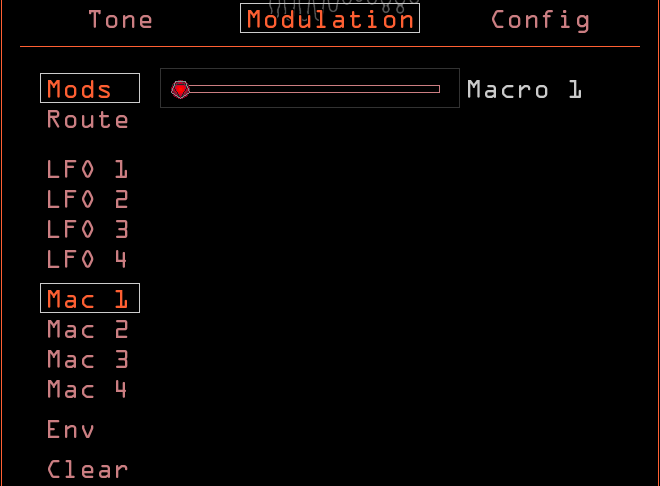
- Mac 1-4
- Four sliders that can be assigned to any number of other parameters, and modulated by LFOs or MIDI CCs.
Env#

- Envelope
- An indicator of the current Envelope modulator value.
- Index
- Sets the range of the Envelope modulator.
Clear#
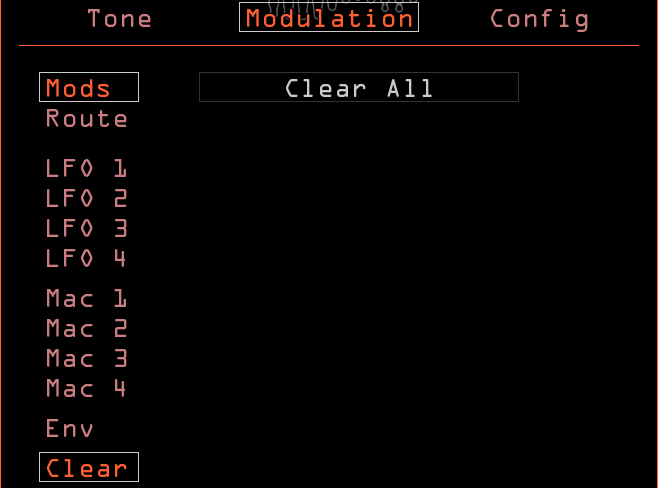
- Clear All Modulation
- Clicking this removes all modulation routings from the patch. Use it wisely.
- Clear All CC Assignments
- Clicking this clears all MIDI CC mappings.
Route page#
When a modulator (LFO, Macro, or Env) is assigned to a parameter, the parameter will appear in this list when on that modulator’s page. For instance, if LFO 1 is modulating Blend, click LFO 1 on the left side to view the modulation amount, curve, and checkbox for Blend (and any other LFO 1-modulated parameters) on the right.
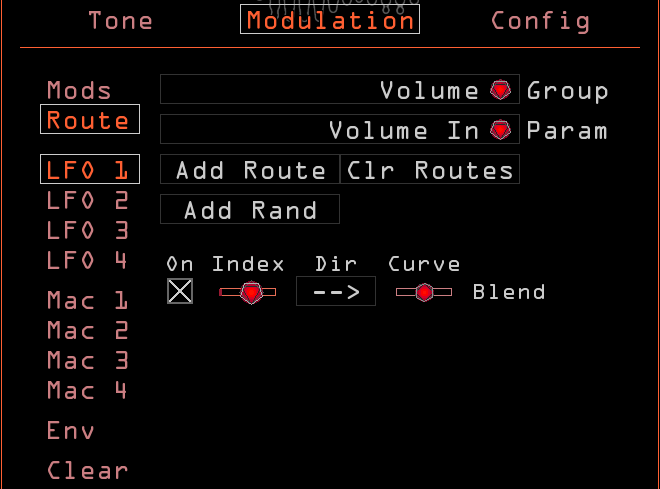
- Group
- Selects a category of parameters, grouped by location in the interface. For example, the Fold parameter is in the Oscillator group.
- Param
- Selects a parameter from the current Group category.
- Add Route
- Adds modulation routing for the selected parameter from the selected modulator.
- Clr Routes
- Click twice to remove all modulation assignments for the current modulator. To remove a single assignment simply uncheck the On box.
- Add Rand
- Adds a random modulation destination.
- On
- Each modulation source has a checkbox; when checked, modulation from that source is enabled. When unchecked on this page, it is removed.
- Index
- Sets the amount of modulation from a particular source. Fully left, modulation is bypassed.
- Dir
- Direction. Sets the polarity and inversion of incoming modulation: * --> (unipolar): modulates from the point selected on the parameter up to the level indicated by the Index setting * <-> (bipolar): modulates around the center point set by the parameter * <-- (inverted unipolar): opposite modulation from unipolar * >-< (inverted bipolar): opposite modulation from bipolar
- Curve
- Each modulation source has a Curve slider that changes how modulation affects the parameter. In the center, modulation is linear, and the parameter movement matches incoming modulation exactly. To the right modulation is more logarithmic, and to the left more exponential.
Config Page#

Controls tab#
- MIDI Learn
- Enables MIDI mapping. (right-click/cmd-click a parameter to bring up the modulation menu and click Learn CC). Please note that many hosts do not support MIDI mapping to effects plugins.
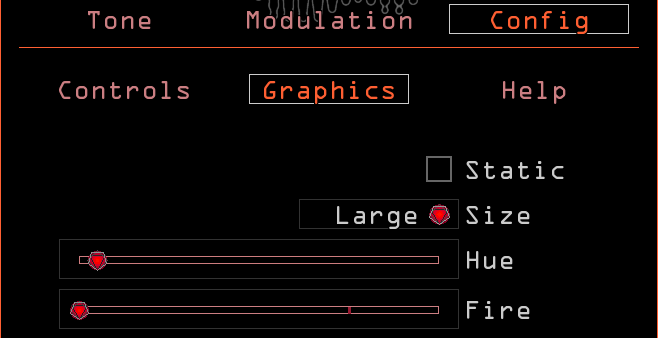
Graphics tab#
- Static
- Adds some retro flare to the plugin GUI.
- Size
- Sets the size of the plugin window.
- Hue
- Sets the color scheme of the plugin.
- Fire
- Adds some attitude to the plugin GUI.
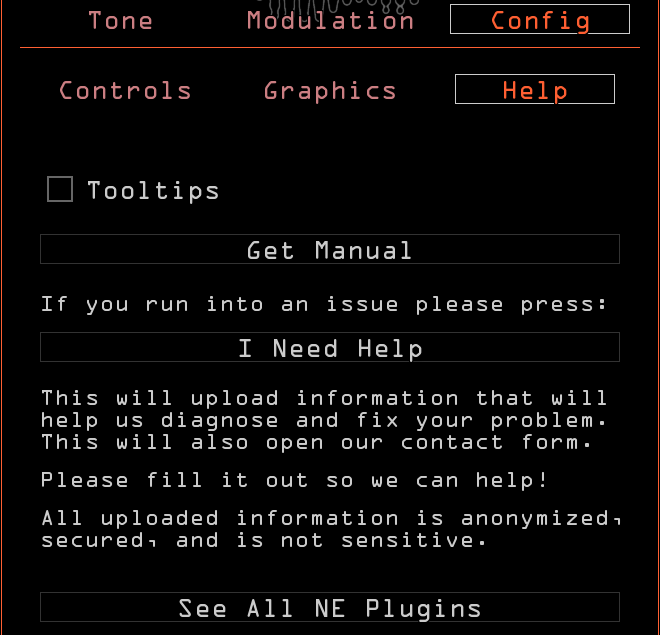
Help tab#
- Tooltips
- Enables helpful tooltips when you mouse over parameters.
- Get Manual
- Opens the plugin product page.
- I Need Help
- Uploads anonymized system information used for troubleshooting and opens the support form. If you’re having an issue please press this button and fill out the form to tell us what the problem is! You can also always reach us at noiseengineering.us/pages/contact. Drop us a line and we’ll get back to you within two business days.
- See All NE Plugins
- Opens the plugin shop. Check out all the Noise!
Plugin Locations#
Plugin presets install to the following locations:
- Windows
- C:\Users\Public\Documents\Noise Engineering\
- Mac
- /Users/[name]/Library/Audio/Presets/Noise Engineering/
Noise Engineering plugins are installed to the default locations for the specified plugin formats. In a majority of cases, plugins will not need to be moved. In the rare instance that you need to move your VST plugins, find them in the following locations:
- Windows
- C:/Program Files/Common Files/VST3/Noise Engineering/
- Mac
- /Library/Audio/Plug-Ins/VST3/
Note that AU and AAX plugins cannot be moved. For reference, they are installed here:
- Mac AU
- /Library/Audio/Plug-Ins/Components/
- Mac AAX
- /Library/Application Support/Avid/Audio/Plug-Ins/Noise Engineering/
- Windows AAX
- C:/Program Files/Common Files/Avid/Audio/Plug-Ins/Noise Engineering/
About NE#
Noise Engineering is located in Los Angeles, California. We started around 2014 when Chief Noisemaker Stephen McCaul wanted a hobby for his off time from his day job and started making Eurorack modules in a spare bedroom at home. One thing led to another and a couple of years later, he and wife Kris Kaiser quit their day jobs and took the company full time. Noise Engineering has since grown in size and has established itself as a well-regarded and innovative synthesizer brand, with products in Eurorack, 5U, and multiple software platforms.
Special thanks#
- Starthief
- René G. Boscio
- Daniel Awbry
- Pino Grzybowsky
- Christian Gibson
- Jake Patel
- iVardensphere
- Stephan Eibel
- Drem Bruinsma
- Øivind Idsø
- Matt Lange
- Greg Chin
- Rhys Fulber
- James Tobias
- Hans Besselink
- Douglas Hill
- Josh Sager
- Yugo Oshima
- Aldo Lamana